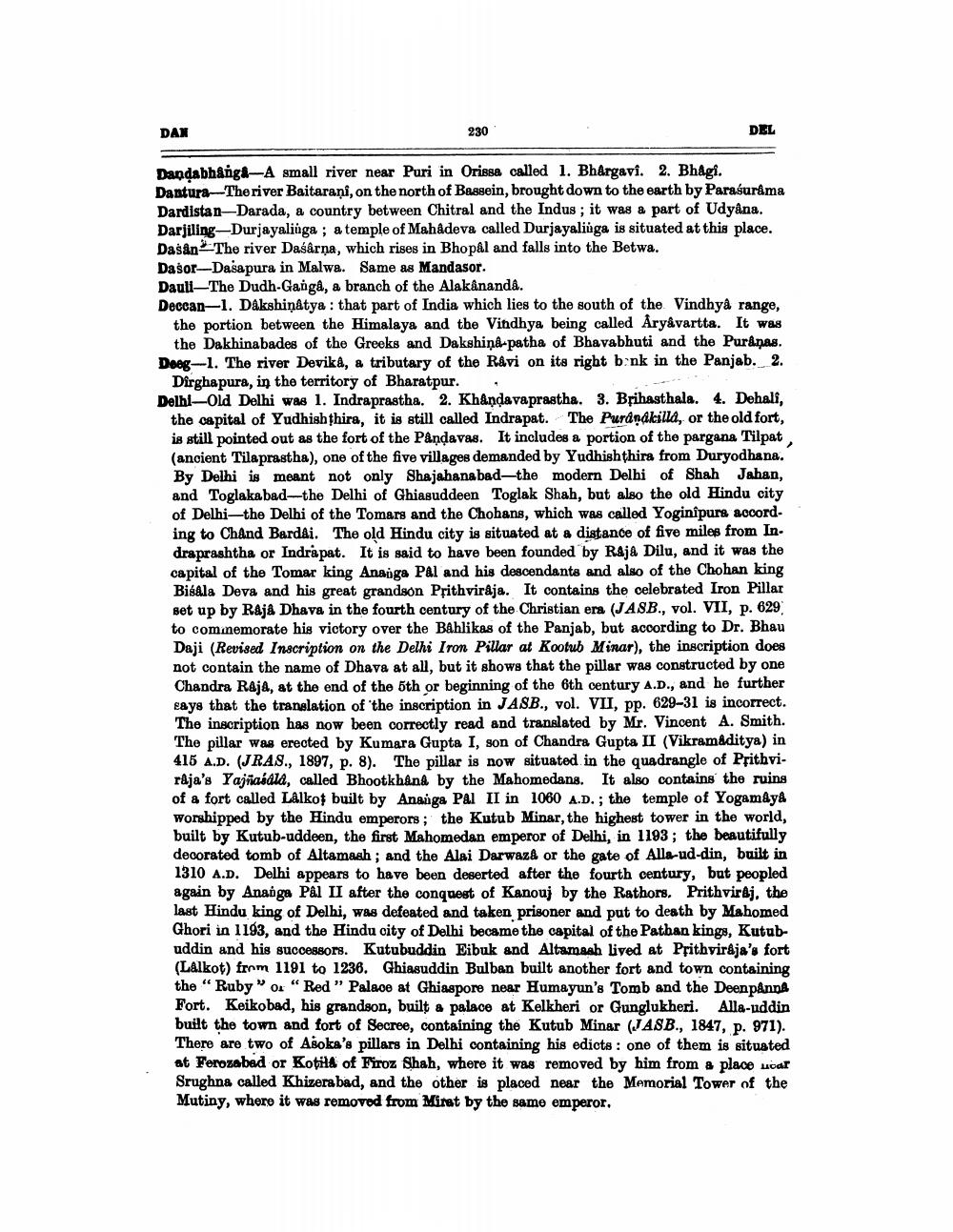________________
DAN
230
DEL
Dandabhängt-A small river near Puri in Orissa called 1. Bhargavi. 2. Bhagi. Dantura--The river Baitarani, on the north of Bassein, brought down to the earth by Parasurama Dardistan-Darada, a country between Chitral and the Indus; it was a part of Udyana. Darjiling-Durjayaliúga ; a temple of Mahadeva called Durjayalinga is situated at this place. Dasån-The river Daśârna, which rises in Bhopal and falls into the Betwa. Dasor-Dasapura in Malwa. Same as Mandasor. Dauli—The Dudh-Ganga, a branch of the Alakånanda. Deccan-1. Dakshingtya : that part of India which lies to the south of the Vindhya range,
the portion between the Himalaya and the Vindhya being called Aryavartta. It was
the Dakhinabades of the Greeks and Dakshiņ&-patha of Bhavabhuti and the Puranas. Doag-1. The river Devika, a tributary of the Ravi on its right bank in the Panjab. 2.
Dirghapura, in the territory of Bharatpur. Delhi-Old Delhi was 1. Indraprastha. 2. Khåndavaprastha. 3. Brihasthala. 4. Dehali, the capital of Yudhishthira, it is still called Indrapat. The Puranåkilld, or the old fort, is still pointed out as the fort of the Pandavas. It includes a portion of the pargana Tilpat, (ancient Tilaprastha), one of the five villages demanded by Yudhishthira from Duryodhana. By Delhi is meant not only Shajahanabad—the modern Delhi of Shah Jahan. and Toglakabad--the Delhi of Ghiasuddeen Toglak Shah, but also the old Hindu city of Delhi-the Delhi of the Tomars and the Chohans, which was called Yogin pure accord. ing to Chand Bardai. The old Hindu city is situated at a distance of five miles from In. draprashtha or Indra pat. It is said to have been founded by Raja Dilu, and it was the capital of the Tomar king Anaoga Pal and his descendants and also of the Chohan king Bisala Deva and his great grandson Prithviraja. It contains the celebrated Iron Pillar set up by Raja Dhava in the fourth century of the Christian era (JASB., vol. VII, p. 629 to commemorate his victory over the Bahlikas of the Panjab, but according to Dr. Bhau Daji (Revised Inscription on the Delhi Iron Pillar at Kootub Minar), the inscription does not contain the name of Dhava at all, but it shows that the pillar was constructed by one Chandra Rają, at the end of the 5th or beginning of the 6th century A.D., and he further says that the translation of the inscription in JASB., vol. VII, pp. 629-31 is incorrect. Tho inscription has now been correctly read and translated by Mr. Vincent A. Smith. The pillar was erected by Kumara Gupta I, son of Chandra Gupta II (Vikramaditya) in 415 A.D. (JRAS., 1897, p. 8). The pillar is now situated in the quadrangle of Prithviraja's Yajñabala, called Bhootkhand by the Mahomedans. It also contains the ruins of a fort called Lalkot built by Ananga Pal II in 1060 A.D.; the temple of Yogamaya Worshipped by the Hindu emperors; the Kutub Minar, the highest tower in the world, built by Kutub-uddeen, the first Mahomedan emperor of Delhi, in 1193; the beautifully decorated tomb of Altamash; and the Alai Darwaza or the gate of Alla-ud-din, built in 1310 A.D. Delhi appears to have been deserted after the fourth century, but peopled again by Anaiga Pal II after the conquest of Kanouj by the Rathors. Prithviraj, the last Hindu king of Delhi, was defeated and taken prisoner and put to death by Mahomed Ghori in 1193, and the Hindu city of Delhi became the capital of the Patban kings, Kutubuddin and his successors. Kutubuddin Eibuk and Altamaah lived at Prithviraja's fort (Lalkot) from 1191 to 1236. Ghiasuddin Bulban built another fort and town containing the "Ruby" ou "Red" Palace at Ghiaspore near Humayun's Tomb and the Deenpanna Fort. Keikobad, his grandson, built a palace at Kelkheri or Gunglukheri. Alla-uddin built the town and fort of Secree, containing the Kutub Minar (JASB., 1847, p. 971). There are two of Asoka's pillars in Delhi containing his edicts: one of them is situated at Ferozabad or Kotill of Firoz Shah, where it was removed by him from a place woar Srughna called Khizera bad, and the other is placed near the Memorial Tower of the Mutiny, where it was removed from Miret by the same emperor,




